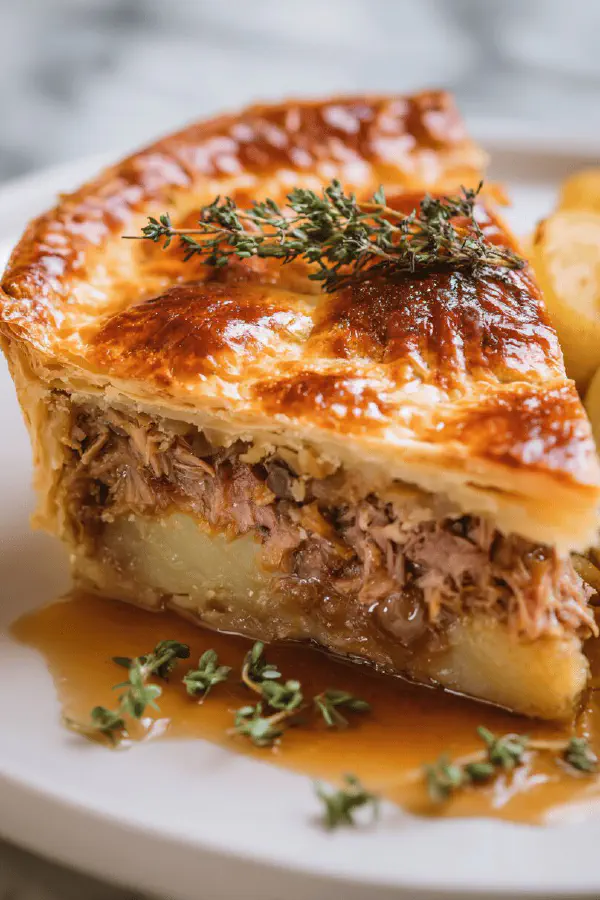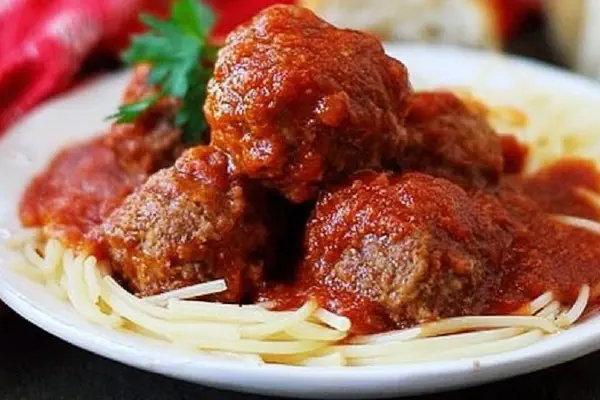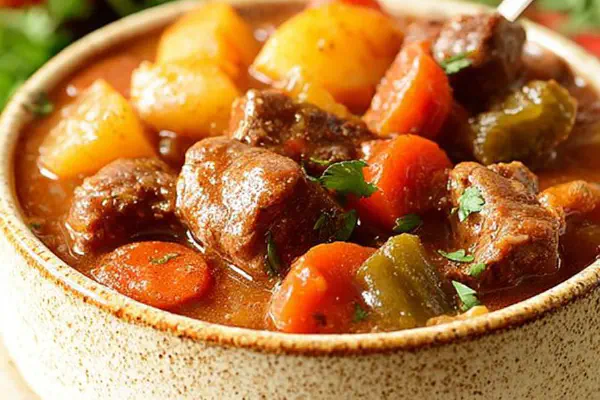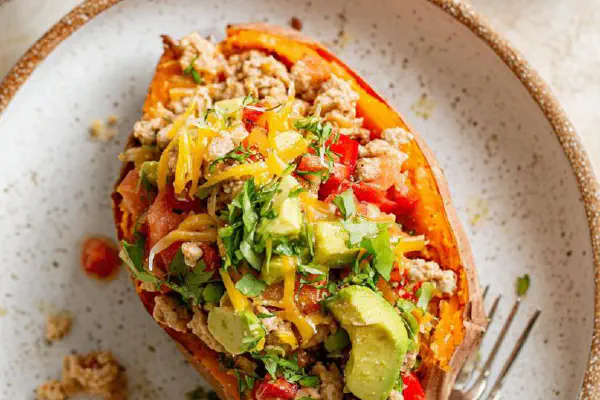Featured Recipe
Braised Pork Duck Tourtière

By Kate
"
A rich tourtière built on slow-braised pork shoulder, combined with shredded duck confit. Thickened with diced Yukon Gold potatoes instead of Russets, adding a waxier texture. The dough is a flaky, salted butter crust, quick-blended, chilled, and rolled thin. The filling simmers until pork cubes give way, juices reduce, and aromatics deepen. Substituted Marsala wine for white for earthier flavor; added a pinch of smoked paprika and fresh thyme to bridge pork and duck. Oven baked till golden, glossy, with a distinct incision for steam release. Comfort and complexity in each cut, layered textures and meaty undertones.
"
Prep:
Cook:
Total:
Serves:
10 servings
French Canadian
comfort food
savory pie
Introduction
Braised pork shoulder cubes, slowly caramelized, mouth-coating fat rendered, puddle polished with deep Marsala richness. Onion translucency releases sweetness, sharpens filling. Yukon Golds add sturdiness, waxy texture that binds instead of disintegrates. Duck confit shredded, tender, adds punch of seasoned depth — no skin or bones preventing an even fold. Salt, pepper, smoked paprika, thyme combine for layers. Dough: salted butter ensures flakiness, rolled thin but strong. Egg yolk glaze for pure shine. Bake until golden, fragrant. Incision vents steam so crust never soggy but brittle-crisp. Interior savory stew, thick without glue. Let sit—even ten minutes helps. Slicing neat, serving simple. Kitchen smells rich of slow braise and butter. Timings flexible, trust senses, not clock.
Ingredients
Glaze
- 1 egg yolk
- 30 ml (2 tbsp) whole milk
- 450 g (3 ½ cups) all-purpose flour unbleached
- 275 g (1 cup plus 2 tbsp) unsalted butter cold, diced
- 2 large eggs
- 200 ml (¾ cup plus 2 tbsp) ice cold water approx
Dough
About the ingredients
Pork shoulder is ideal for slow braising; leaner cuts will dry out. Trim visible fat to avoid greasy filling but keep some marbling for softness. Grapeseed oil or other neutral fats tolerate higher heat for browning better than olive oil, which can burn and leave bitterness. Using Marsala replaces simpler white wine; its tannins and sweetness deepen flavor, tying better with duck. Yukon Gold potatoes hold shape better than Russets, which tend to break down into mush, useful but less textural contrast. Duck confit must be fully drained and shredded to remove excess oil and prevent greasy pie. Butter is unsalted to control salt balance since pork and stock add sodium. Egg yolk glaze mixed with milk or cream promotes color and slight shine, essential for rustic yet polished crust finish. Dough should be chilled thoroughly before rolling to prevent shrinking and maintain flakes. Water must be ice cold, especially in warm kitchens, to ensure butter stays firm during mixing.
Method
Filling Preparation
- Dry pork on paper towels; crucial to brown well without steaming. Heat grapeseed oil in heavy skillet over medium-high. Brown pork in batches so cubes don’t overcrowd and sweat. Look for even golden crust, not black spots. Salt and pepper immediately after browning. Transfer pork to large Dutch oven or heavy pot.
- In the same skillet, lower heat to medium, add diced onion. Wait till translucent, edges soft, smell sweet onion aroma; about 6 minutes. Deglaze skillet with Marsala wine. Scrape brown bits loose with wooden spatula; this is flavor base. Pour over pork in pot.
- Add beef stock, thyme, smoked paprika. Bring to strong simmer. Cover and lower heat to gentle poach. You want barely bubbling, slow movement in liquid. Simmer 1 hour 10 minutes uncovered or until pork starts becoming tender but still holds shape.
- Add potatoes and shredded duck confit. Stir gently, avoiding breaking pork cubes. Bring back to simmer uncovered. Cook additional 35 minutes or until potatoes are soft but not falling apart; should start to thicken the stew. Season to taste with salt and pepper. Remove thyme stems. Let mixture cool to near room temperature, crucial for easy filling later.
- Sift flour into food processor bowl. Add cold butter pieces. Pulse in short bursts, watch closely, you want pea-sized butter lumps coated in flour; this gives flakiness. Avoid melting butter – keep pulses quick and cold. If you don’t have a processor, rub cold butter with fingers into flour but work fast to avoid warming.
- Add eggs and 150 ml cold water gradually via spout. Pulse only until dough just clumps but isn’t wet or sticky. Dough should come together but remain slightly shaggy. Add more ice water cautiously, 1 tbsp at a time if needed. Avoid overworking to prevent toughness.
- Tip dough onto floured board, form into two disks, wrap tightly in plastic. Chill minimum 45 minutes. Chilling rests gluten and solidifies butter, essential for tender crust and rolling ease.
- Preheat oven to 185°C (365°F). Place oven rack in lower third.
- Lightly flour workspace. Roll out two-thirds of dough to about 3 mm thickness. Line a 2.5-liter (10 cup) casserole or heavy pot with this dough, leaving a generous overhang (about 3-4 cm). Avoid stretching; if dough shrinks, rest 10 minutes, then re-roll carefully.
- Pour cooled filling evenly into lined pot. No excess liquid should pool; if too wet, drain or reduce liquid by simmering longer next time.
- Brush rim of dough with egg yolk and milk glaze. Roll out remaining dough disk to a circle just wider than pot opening. Cover filling with second dough round, pressing edges to seal well. Crimp or flute edges for tight seal—prevents filling leaks during baking.
- Brush top crust generously with glaze to encourage golden color. Cut a small central steam vent: slit about 2 cm to let gases escape without deflating crust.
- Place pot on baking tray to catch drips. Bake 1 hour 25 minutes or until crust is deep golden brown, sound hollow when tapped. Hot filling will bubble up slight steam through vent.
- Remove from oven; cool uncovered 20 minutes minimum. This allows filling to settle, makes slicing cleaner.
- Serve slightly warm with crisp greens or pickled vegetables to cut richness.
- If crust siblings soggy: next time chill dough longer; blind bake bottom crust for 8 minutes before filling if needed.
- No Marsala? Dry sherry or a dry white wine works; avoid sweet wines which alter the savory balance.
- No duck confit? Slow roast chicken thighs in oil and shred as sub.
- Storage: stays stable refrigerated up to 3 days. Reheat in moderate oven to keep crust crisp.
- Avoid dry filling: potatoes absorb fat and broth; don’t skip them or add breadcrumbs instead.
- Watch crust edges: if browning too fast, tent with foil after 50 minutes.
- Don’t overpack filling; 2.5L vessel volume critical to allow dough seal and expansion.
Dough Preparation
Assembly
Serving Tips & Troubleshooting
Technique Tips
Browning pork develops Maillard compounds, foundation of flavor. Avoid overcrowding pan; crowding causes steaming, no crust. Degauling pan with Marsala unlocks pan fond, unlocking richness. Slow simmering fills pot with aroma but avoid rolling boil which toughens pork. Simmer uncovered after adding potatoes reduces excess moisture, concentrating flavors and thickening naturally. Rolling dough quickly stops butter melting; keep fingers cold; rinse flour often to prevent sticking. Avoid overmixing dough; overworked gluten yields tough crust. Rest dough in fridge minimum 45 minutes to relax gluten, chill butter. Rolling dough without stretching allows uniform thickness, avoids shrinkage during baking. Sealing edges with egg wash ensures edges bond firmly preventing steam leaks. Slit in top crust lets steam escape; no vent means soggy crust and torn pie. Baking at moderate 185°C promotes even browning inside and out. Resting pie post-baking crucial for filling to set, stopping runny messes when cut. Cool pie on wire rack to let steam escape bottom crust, keeping it crisp. Slashing dough properly avoids blowouts. Keep baking tray under pie to catch drips and avoid oven mess. If crust edges brown too fast, tent foil to avoid burning without sacrificing overall baking.
Chef's Notes
- 💡 Use a heavy skillet to brown pork—Maillard reaction essential. Pat dry pork cubes. Overcrowding causes steaming. Look for golden color, not burnt. Season immediately after browning. Transfer to a pot for simmering.
- 💡 Potato choice matters. Yukon Golds hold shape. Don't substitute with Russets or breadcrumbs—texture of filling changes. They absorb fat but remain intact. Cooking uncovered helps thicken the filling.
- 💡 Chill dough long. Resting allows gluten to relax. Keep butter cold, use ice water; room temp water ruins flakiness. Be wary of overworking dough, avoid toughness. Rolling should be even, don't stretch it.
- 💡 Seal edges well with glaze. An egg wash prevents steam leaks during baking. If venting isn’t done, crust becomes soggy. Cut a small slit in top crust to allow steam to escape.
- 💡 Baking temperature—critical. 185°C for balanced browning. If crust edges brown too quickly, tent with foil. Let pie cool after baking, helps filling set before slicing.
- 💡 Storage is flexible. Cool down before refrigerating. Lasts 3 days in fridge. Reheat in moderate oven for crispiness. Always aim to keep crust intact, consider reheating methods.
Kitchen Wisdom
How do I achieve the best crust
Keep butter cold. Don’t skip chilling. Blind baking helps. Rolling without stretching prevents shrink. The crust should be golden, firm to the touch.
Alternatives for duck confit
Use chicken thighs, shredded. Similar richness, make sure to season well. Don’t skip on herb balance, like thyme. Versatile enough to work in various meats.
What if filling is too wet
Drain some liquid before filling the dough, or simmer longer to reduce. Balance is key. Do not add breadcrumbs; they alter texture completely.
What's best for storing
Option one—cool pie down thoroughly, refrigerate covered. Option two—freeze before baking. Best results come with proper storage methods. Consider reheating details for crispy crust.



